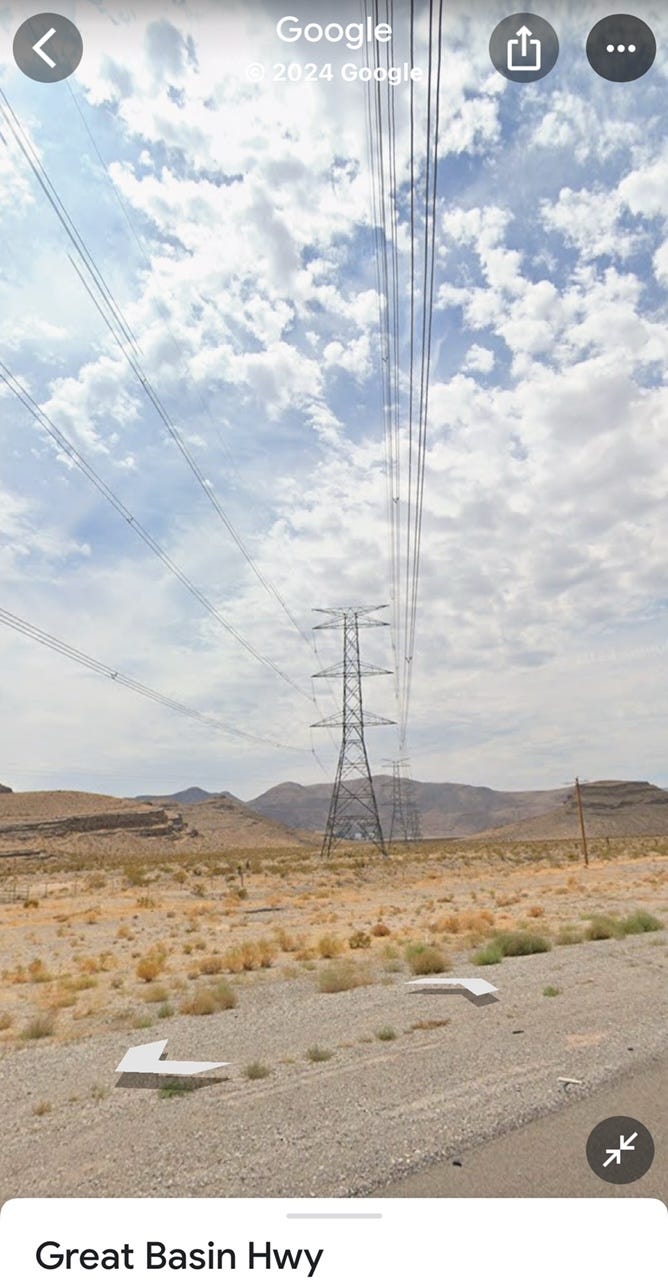Power Line induced hot-skin voltage
Don't park your RV under high-voltage power lines... A Google Earth example.
Hi Mike,
Thank you for all the great info you provide. I was wondering about risks to my electrical system and safety risks due to hot skin voltage caused by parking under power lines.
I parked my 25ft airstream here and received a shock from a distance of about 3/16th inch of the trailer. Click the picture for the link. While alarming at first, it was high voltage and low amperage so it didn’t hurt me, but what if it were raining or i was running around barefoot or even touching an external metal ground (like the nearby guardrail).
Thank you! - Neil
Hey Neil,
Thanks for providing the Google Earth link which I annotated above. As you guessed, parking your RV right under the power lines did induce a high-voltage, low-current voltage in your RV and Tow Vehicle. But how high of a voltage, and how dangerous could it be?
Let’s take a closer look…
Here’s the actual road view of your parking location. Note that those are very-high voltage power lines. Others on this newsletter can probably make a more accurate guess from the length of the insulators, but my SWAG is as much as 500,000 volts. (Did I guess correctly?)
Induced voltage
I’ve written about this previously, and posted an article from a power company describing the precautions needed when working under these high-voltage power lines. You can download a copy of the report below.
Living And Working Safely Around High Voltage Power Lines
5.67MB ∙ PDF file
In short, according to my discussions with the power company engineer who wrote this article, the current should be limited to less than 5mA, which is considered to be non-lethal. But it can really hurt.
However, the induced voltage can reach 10’s of thousands of volts, which is enough to make a spark plug “spark” continuously. And if you’ve ever grabbed a spark plug on a running lawn mower (like I have), it will certainly get your attention. And yes, it can easily jump a 3/16” gap to your hand. Ouch!
Let’s play safe out there… Mike










Wow, I did not realize that there are RV or any other campgrounds under high voltage transmission lines but I guess it’s not too surprising.
It should be noted that a hot skin condition could be induced by HV AC but not by HV DC transmission lines. There are relatively few HVDC lines compared to HVAC but more are planned in the future.
It is a bit scary to think that a large all-metal skinned travel trailer like an Airstream, while a great Faraday shield, will also act like a relatively large capacitor under an HVAC transmission line forming a capacitive voltage divider. One could do the math and estimate how much voltage could be induced on the skin of the RV based on the sizes and distances involved but hundreds of volts seems quite plausible. Therefore, it’s not at all surprising to hear that the Airstream owner in the article got a whopping shock when parked under a HVAC transmission line. It wasn’t clear if this was an RV park or a boondocking location but I’d certainly want to avoid camping there in any case. It’s no clear how big of a shock, if any, someone would receive if they were in a non-metal skinned RV.
In my experience, you can hear the hissing of the corona discharge around HVAC lines and also smell the ozone created by it. Not a healthy thing to breathe for extended times. Thanks Mike for raising our awareness of this interesting and unusual RV camping hazard.
Mike, What would an electrical leak that would normally cause a hot condition look like for an RV not clad in metal? How would you detect it?